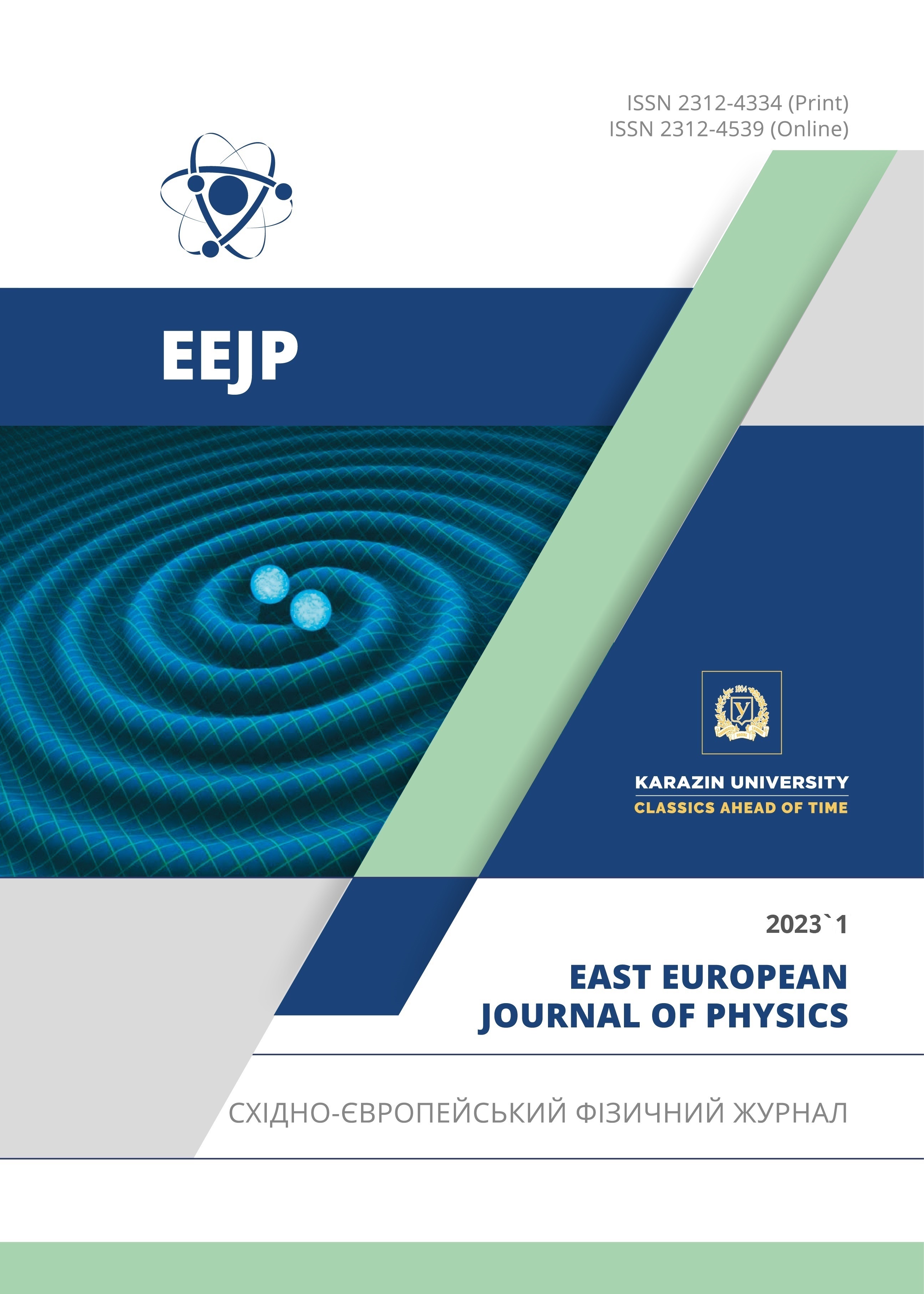Effect of Competing Ions on Multisorption (Cs+, Sr2+) by Composite Sorbents Based on Natural and Synthetic Zeolites
Abstract
In the course of the research, the effect of competing ions (Na+) on multisorption (Cs+, Sr2+) by composite sorbents based on natural and synthetic zeolites under static conditions was studied. It was found that the maximum concentration of competing ions (0.4 g of NaCl per 100 ml of solution) leads to a decrease in cesium sorption by 20%, and strontium sorption decreases by 10%. At the same time, high rates of sorption of cesium and strontium are preserved. Thus, for a composite sorbent (clinoptilolite -30%: zeolite NaX -70%), the sorption of cesium was 67.9%, and the sorption of strontium was 87.6%. The analytical technique was developed on the basis of the PIXE (Proton Induced X-ray Emission) method and made it possible to qualitatively and quantitatively determine the content of isotopes. The work was performed at the analytical nuclear-physical complex "Sokil". The energy range of the electrostatic accelerator is 200-2000 keV. The complex made it possible to carry out all the main methods of analysis using ion beams. The targets were placed in the exit, at the Chamber for PIXE. To carry out measurements, a vacuum with a pressure of 10-4 Pa was created in the chamber. To excite the atoms of cesium, strontium, a proton beam with an energy of Ер≈1400 keV was used. The characteristic X-ray radiation of the L-series of cesium atoms and K-series of strontium atoms was recorded by two detectors: XR-100CR Si-PIN X-Ray and Ge(HP). The sorption coefficient (Sorption, %) was used as a quantitative characteristic of the interaction of sorbents with cesium, strontium.
Downloads
References
Management of radioactive waste during the operation of the NPP of the SE, "NAEK "Energoatom". https://www.energoatom.com.ua/uploads/others/RAO_2018.pdf, 2020 (accessed of 31 December 2020)
State Nuclear Regulatory Inspectorate of Ukraine, Report on the state of nuclear and radiation safety in UKRAINE in 2020. https://snriu.gov.ua/storage/app/sites/1/uploaded-files/%D0%94%D0%BE%D0%BF%D0%BE%D0%B2%D1%96%D0%B4%D1%8C_%D0%AF%D0%A0%D0%91_2020_EN.pdf
F.M. McEvoy, D.I. Schofield, R.P. Shaw, and S. Norris, Science of The Total Environment, 571, 507 (2016). https://doi.org/10.1016/j.scitotenv.2016.07.018
Uatom, Kyiv, Ukraine, Radwaste Management at Operating NPPs, https://www.uatom.org/en/radwaste-management-at-operating-npps
R.O. Abdel Rahman, H.A. Ibrahium, and Yung-Tse Hung, Water, 3(2), 551 (2011). https://doi.org/10.3390/w3020551
M. Šljivić-Ivanović, and I. Smičiklas, “Advances in Construction and Demolition Waste Recycling”, Woodhead Publishing Series in Civil and Structural Engineering, 475 (2020). https://doi.org/10.1016/B978-0-12-819055-5.00023-1
L.A. Henry, and V. Douhovnikoff, Annual Review of Environment and Resources, 33, 437 (2008). https://doi.org/10.1146/annurev.environ.33.051007.082437
F. Šebesta, J. John, A Motl, V. Peka, and E. Vacková, JRNC, 220(1), 65 (1997). https://doi.org/10.1007/BF02035349
L.G. Gerasimova, D.V. Maiorov, M.V. Maslova, V.A. Matveev, and V.M. Shcherbakov, International scientific journal “Alternative energy and ecology”, 2(22), 39 (2005). https://cyberleninka.ru/article/n/razrabotka-tehnologii-polucheniya-i-primeneniya-sorbentov-radionuklidov-na-osnove-tehnogennyh-othodov-obogascheniya-apatito (in Russian)
D. Breck, Zeolite molecular sieves, (Wiley, New York, 1974).
A.R. Jule, Chemistry of zeolites and catalysis, (American Chemical Society,1976).
C.B. Amphlett, Inorganic ion exchangers, (Elsevier Publishing Company, Amsterdam, London, New York, 1964).
A.Yu. Lonin, V.V. Levenets, O.P. Omelnik, and A.O. Shchur, “Removal of a mixture of Cs, Sr and Co cations from an aqueous solution using composite sorbents based on natural and synthetic zeolites”, JRNC, 331, 5517 (2022). https://doi.org/10.1007/s10967-022-08637-y
T.-J. Liang, and C.-N. Hsu, “Sorption of Cesium and Strontium on Natural Mordenite”, Radiochimica Acta, 61, 105 (1993). https://doi.org/10.1524/ract.1993.61.2.105
K.M. Abd El-Rahman, M.R. El-Sourougy, N.M. Abdel-Monem, and I.M. Ismail, Journal of Nuclear and Radiochemical Sciences, 7(2), 21 (2006). https://doi.org/10.14494/jnrs2000.7.2_21
T. Abdollahi, J. Towfighi, and H. Rezaei-Vahidian, Environmental Technology & Innovation, 17, 100592 (2020). https://doi.org/10.1016/j.eti.2019.100592
Y. Izosimova, I. Gurova, I. Tolpeshta, M. Karpukhin, S. Zakusin, O. Zakusina, A. Samburskiy, and V. Krupskaya, “Adsorption of Cs(I) and Sr(II) on Bentonites with Different Compositions at Different pH”, Minerals, 12, 862 (2022). https://doi.org/10.3390/min12070862
X.-H. Fang, F. Fang, C.-H. Lu, and L. Zheng, Nuclear Engineering and Technology, 49(3), 556 (2017). https://doi.org/10.1016/j.net.2016.11.008
A.Yu. Lonin, V.V. Levenets, O.P. Omelnik, A.O. Shchur, JRNC, 329, 135 (2021), https://doi.org/10.1007/s10967-021-07762-4
V.V. Levenets, A.Yu. Lonin, O.P. Omelnik, A.O. Shchur, JECE, 4(4), 3961(2016), https://doi.org/10.1016/j.jece.2016.09.011
A.Yu. Lonin, V.V. Levenets, I.M. Neklyudov, A.O. Shchur, JRNC, 303, 831 (2015), https://doi.org/10.1007/s10967-014-3597-9
V.V. Levenets, A.Yu. Lonin, O.P. Omelnik, and A.O. Shchur, X-Ray Spectrometry, 44(6), 447 (2015), https://doi.org/10.1002/xrs.2626
Copyright (c) 2023 Oleksii Yu. Lonin, Volodymyr V. Levenets, Oleksandr P. Omelnyk, Andriy O. Shchur

This work is licensed under a Creative Commons Attribution 4.0 International License.
Authors who publish with this journal agree to the following terms:
- Authors retain copyright and grant the journal right of first publication with the work simultaneously licensed under a Creative Commons Attribution License that allows others to share the work with an acknowledgment of the work's authorship and initial publication in this journal.
- Authors are able to enter into separate, additional contractual arrangements for the non-exclusive distribution of the journal's published version of the work (e.g., post it to an institutional repository or publish it in a book), with an acknowledgment of its initial publication in this journal.
- Authors are permitted and encouraged to post their work online (e.g., in institutional repositories or on their website) prior to and during the submission process, as it can lead to productive exchanges, as well as earlier and greater citation of published work (See The Effect of Open Access).








